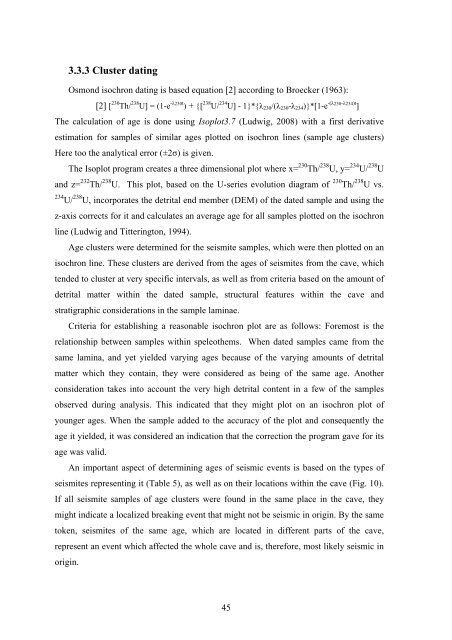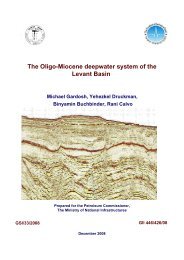tivity on the carmel faul
tivity on the carmel faul
tivity on the carmel faul
You also want an ePaper? Increase the reach of your titles
YUMPU automatically turns print PDFs into web optimized ePapers that Google loves.
3.3.3 Cluster dating<br />
Osm<strong>on</strong>d isochr<strong>on</strong> dating is based equati<strong>on</strong> [2] according to Broecker (1963):<br />
[2] [ 230 Th/ 238 U] = (1-e -λ230t ) + {[ 238 U/ 234 U] - 1}*{λ 230 /(λ 230 -λ 234 )}*[1-e -(λ230-λ234)t ]<br />
The calculati<strong>on</strong> of age is d<strong>on</strong>e using Isoplot3.7 (Ludwig, 2008) with a first derivative<br />
estimati<strong>on</strong> for samples of similar ages plotted <strong>on</strong> isochr<strong>on</strong> lines (sample age clusters)<br />
Here too <strong>the</strong> analytical error (±2σ) is given.<br />
The Isoplot program creates a three dimensi<strong>on</strong>al plot where x= 230 Th/ 238 U, y= 234 U/ 238 U<br />
and z= 232 Th/ 238 U. This plot, based <strong>on</strong> <strong>the</strong> U-series evoluti<strong>on</strong> diagram of 230 Th/ 238 U vs.<br />
234 U/ 238 U, incorporates <strong>the</strong> detrital end member (DEM) of <strong>the</strong> dated sample and using <strong>the</strong><br />
z-axis corrects for it and calculates an average age for all samples plotted <strong>on</strong> <strong>the</strong> isochr<strong>on</strong><br />
line (Ludwig and Titteringt<strong>on</strong>, 1994).<br />
Age clusters were determined for <strong>the</strong> seismite samples, which were <strong>the</strong>n plotted <strong>on</strong> an<br />
isochr<strong>on</strong> line. These clusters are derived from <strong>the</strong> ages of seismites from <strong>the</strong> cave, which<br />
tended to cluster at very specific intervals, as well as from criteria based <strong>on</strong> <strong>the</strong> amount of<br />
detrital matter within <strong>the</strong> dated sample, structural features within <strong>the</strong> cave and<br />
stratigraphic c<strong>on</strong>siderati<strong>on</strong>s in <strong>the</strong> sample laminae.<br />
Criteria for establishing a reas<strong>on</strong>able isochr<strong>on</strong> plot are as follows: Foremost is <strong>the</strong><br />
relati<strong>on</strong>ship between samples within speleo<strong>the</strong>ms. When dated samples came from <strong>the</strong><br />
same lamina, and yet yielded varying ages because of <strong>the</strong> varying amounts of detrital<br />
matter which <strong>the</strong>y c<strong>on</strong>tain, <strong>the</strong>y were c<strong>on</strong>sidered as being of <strong>the</strong> same age. Ano<strong>the</strong>r<br />
c<strong>on</strong>siderati<strong>on</strong> takes into account <strong>the</strong> very high detrital c<strong>on</strong>tent in a few of <strong>the</strong> samples<br />
observed during analysis. This indicated that <strong>the</strong>y might plot <strong>on</strong> an isochr<strong>on</strong> plot of<br />
younger ages. When <strong>the</strong> sample added to <strong>the</strong> accuracy of <strong>the</strong> plot and c<strong>on</strong>sequently <strong>the</strong><br />
age it yielded, it was c<strong>on</strong>sidered an indicati<strong>on</strong> that <strong>the</strong> correcti<strong>on</strong> <strong>the</strong> program gave for its<br />
age was valid.<br />
An important aspect of determining ages of seismic events is based <strong>on</strong> <strong>the</strong> types of<br />
seismites representing it (Table 5), as well as <strong>on</strong> <strong>the</strong>ir locati<strong>on</strong>s within <strong>the</strong> cave (Fig. 10).<br />
If all seismite samples of age clusters were found in <strong>the</strong> same place in <strong>the</strong> cave, <strong>the</strong>y<br />
might indicate a localized breaking event that might not be seismic in origin. By <strong>the</strong> same<br />
token, seismites of <strong>the</strong> same age, which are located in different parts of <strong>the</strong> cave,<br />
represent an event which affected <strong>the</strong> whole cave and is, <strong>the</strong>refore, most likely seismic in<br />
origin.<br />
45

















